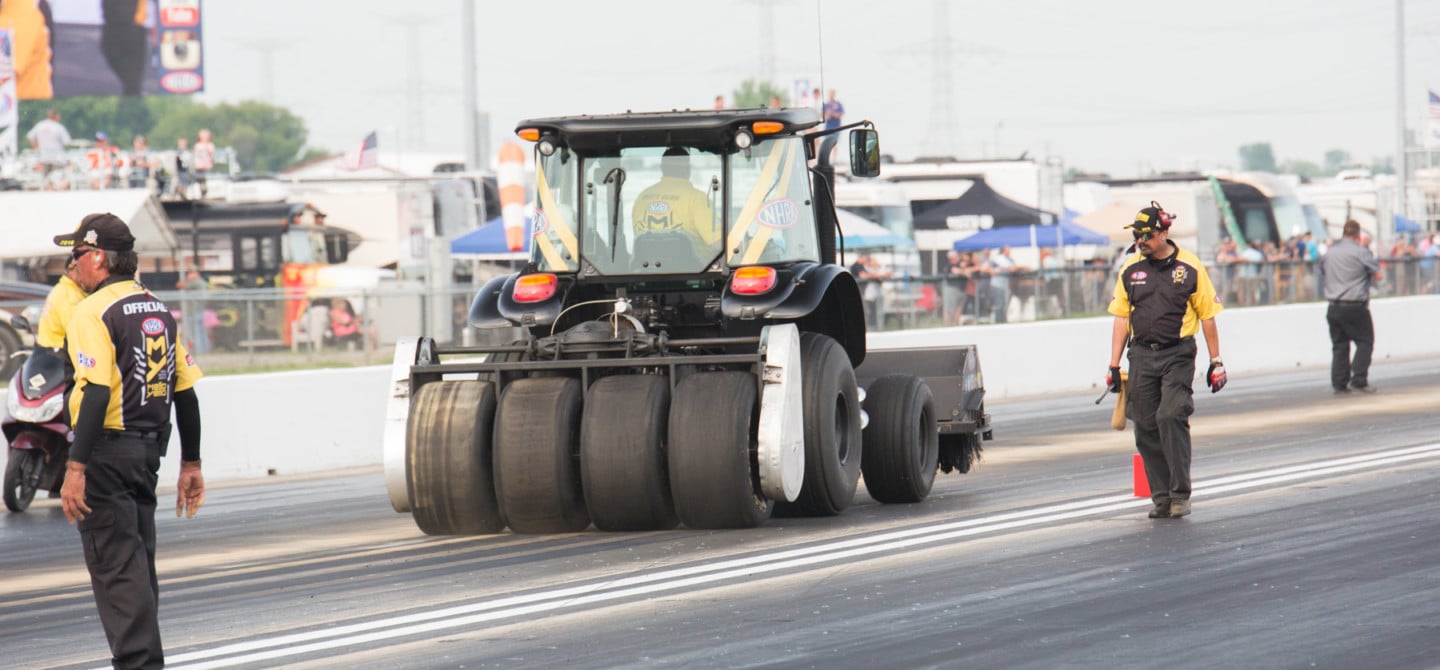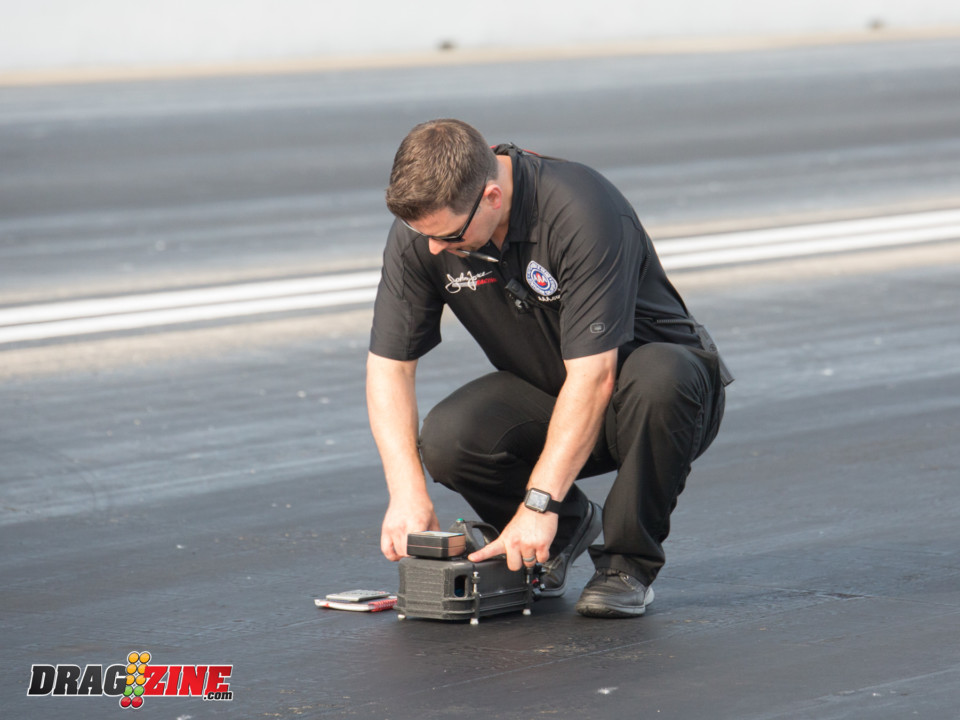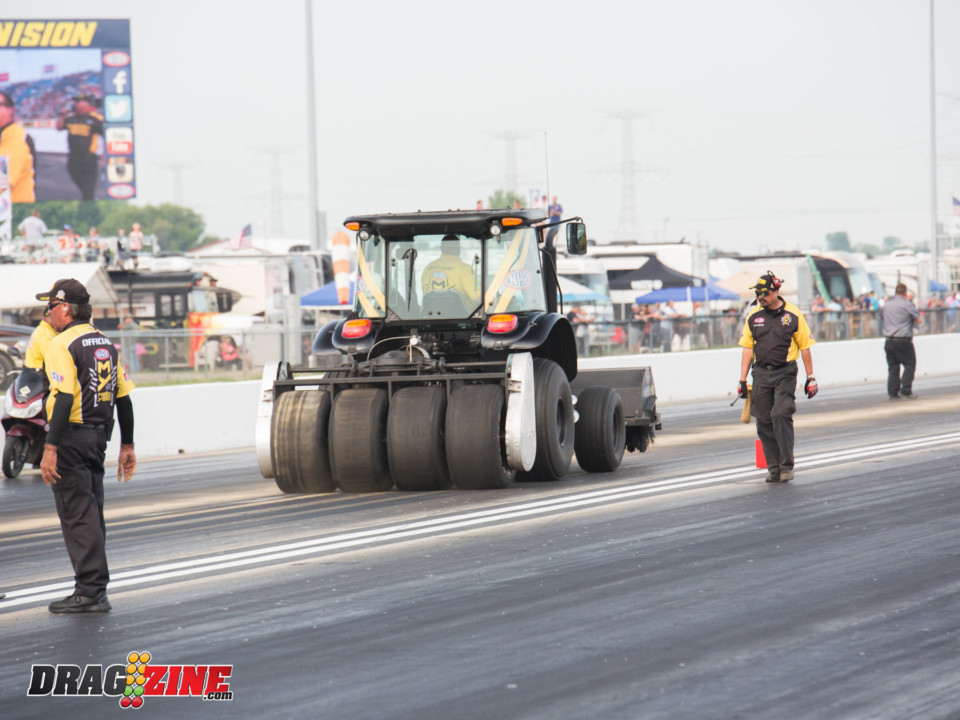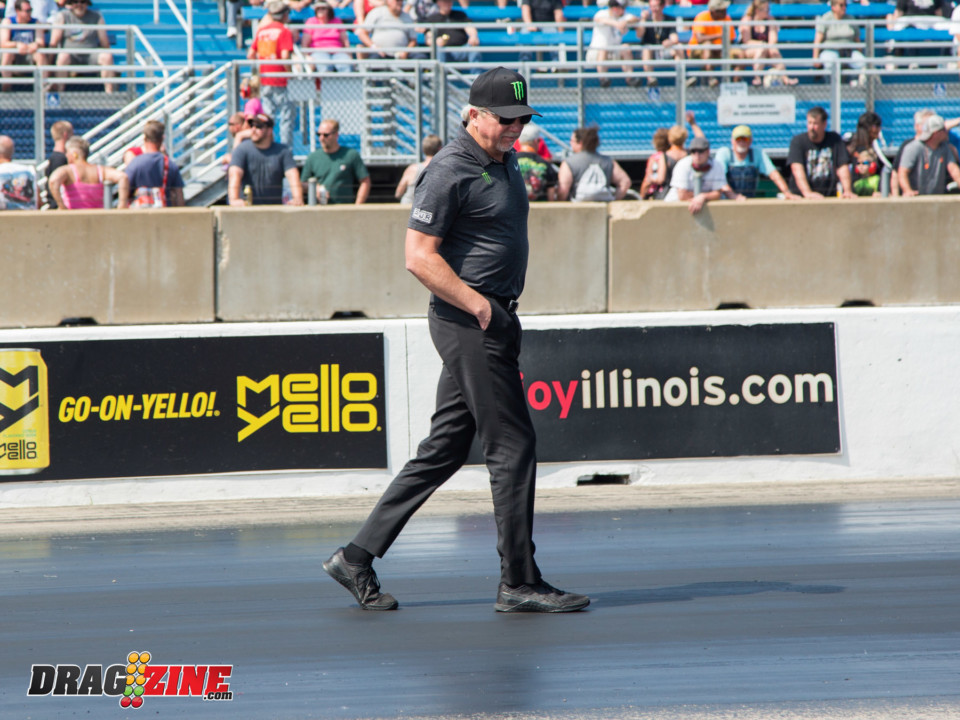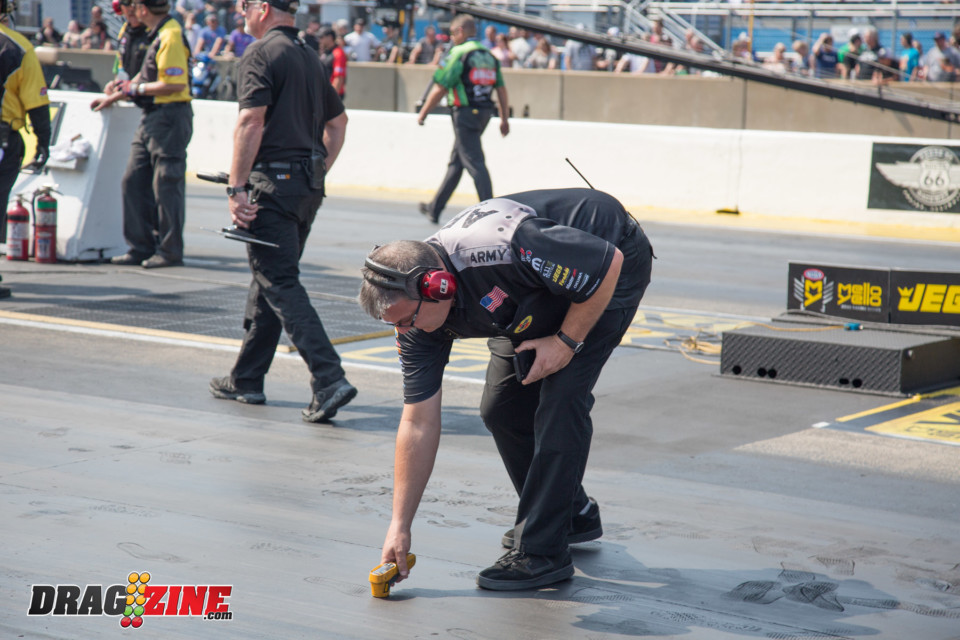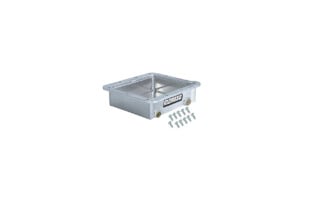Since the April race at Houston, NHRA racers and fans have squawked about the new track-prep method.
And perhaps the most practical of all who have weighed in is Funny Car contender JR Todd. In a recent episode of “Nomex Effect,” his podcast with Kalitta Motorsports teammate Shawn Langdon, Todd said, “This track-prep deal, it’s almost like beating a dead horse at this point. It most likely isn’t going to change anytime soon.”
The NHRA’s decision to remix the traction compound-to-alcohol ratio for the two nitro classes – from 75 percent compound and 25 percent alcohol to 65 percent compound and 35 percent alcohol – has drawn some anger.
Before hearing some of the who-said-what reactions, consider a few truths (in no special order):
- Many racers have said they believe the fuel cars need to slow down. It’s impossible to know if they truly mean that or if it sounds politically correct – or if they’re conflicted about it. But racers, and certainly tuners, don’t want to slow down. The reason they race is the thrill of how it feels to blast down a dragstrip at 330 or so miles an hour. As Matt Hagan said, “You can’t get that rush anywhere else.” Maybe those in favor of slower cars just have trouble communicating that they want the cars to go quicker and faster, yet offer safer and safer features. Enough double-talk.
- Crew chiefs have not shown much interest in slowing down the cars. That’s nothing new at all. About 10 years ago, legendary tuner Austin Coil figured the cars could be equipped with all kinds of protective packaging but said fans would be turned off because the cars would look like tanks lumbering down the racetrack. Besides, liver and broccoli are nutritionally sound, and neither is wildly popular. Crew chiefs will behave like “techno-brats” and figure out a way legally to follow rules but twist or tweak something else to gain an advantage. They’re choosing the cookies and ice cream over liver and broccoli.
- Both those for the new method and those against it cite the fan experience. Some racers genuinely do care about the fans, some racers not so much. The litmus test is how much time they spend at the rope lines and how friendly and accessible they are (within reason) for those who spend their disposable income at the dragstrip.
- Just as when the NHRA decided in 2008 to shrink the course for Top Fuel and Funny Car from the traditional quarter-mile to 1,000 feet, the argument arose about how discerning the average fan is about elapsed times and speeds. Would they notice the difference? It’s hard to say whether the fans would notice a change, especially if it’s relatively slight (from a spectator point of view).
- The NHRA has not only the responsibility but the right to adjust physical racing-operation parameters to ensure safety for racers and fans. If they neglected that tenet everyone trusts them to uphold, then the sport would be in trouble on a variety of fronts. So it has to consider the fact that these tracks were constructed decades ago and might not be as responsive to modern technology that’s growing in unprecedented leaps.
- The sanctioning body also is the entity that teams expect to help curb costs. As Graham Light said, some of the escalating expenses are matters beyond the NHRA’s control (such as hotel rates that vary across the country and gasoline or diesel prices for the haulers and motorhomes that travel to races). No track wants the schedule trimmed – at least not its own date(s). The NHRA doesn’t want to lop off any of its existing markets – and has designed the seemingly odd jumping-bean pattern to the schedule to avoid saturating markets. It might make sense logistically to race throughout the Southeast while the tour is there or at Dallas and Houston in successive weekends. But the fear is that ticket sales will drop. So what’s the answer? Where’s Dear Abby when we need her?
- No matter who says what, the NHRA cannot accommodate everyone. Although the timing of this track-prep decision was a bit goofy (why not start it at the beginning of the year and give teams time to prepare their tune-ups?), it appears rescinding it isn’t up for discussion. So Todd is right. And maybe support from PRO was grudging, but reportedly PRO signed off on it.
- It’s fair to say the new track prep has helped to level the playing field and give others besides the 11 combined Don Schumacher Racing and John Force Racing drivers a shot at going more rounds. But to say it is the sole reason drivers, notably Scott Palmer and Terry McMillen in Top Fuel, have improved results is to ignore the fact they made major strides last season. Other factors have played into their performance gains.
- Legal liability surely factored into the decision.
So back to the grumbling . . . And that’s about all it was until Hagan, the two-time Funny Car champion and Courtney Force’s closest rival in the standings, confronted the issue after the Charlotte race and opened the conversation.
The car only does what the tuner tells it to do. A lot of times I see the track and the track prep being the scapegoat for a car losing traction. My opinion is it’s the tuner’s job to make the proper adjustments. – Tony Pedregon
“There’s a lot less grip out there, and that’s why everyone’s smoking the tires and blowing up,” he said. “Hopefully, they can get this situation figured out. The car’s not going down the racetrack anymore. I think all drivers are having to be kind of ready to pedal. In qualifying, you just lift. But on race day, you’re sitting in there, trying to prepare yourself mentally about what you’re going to do in some of these situations. Unfortunately, doing that, legging these things out when they smoke the tires and put holes out, it blows the bodies off of them and makes for chaos. Sorry I was a little blunt, but it is what it is.”
His Twitter post went farther: “I’ll say it cause no one else will say it. NHRA should be embarrassed for the show that we put on in Charlotte. I’m very sorry to all our fans that paid to see that. NHRA has changed track prep up to slow the cars down and end result is tire smoke, explosions and a poor show!!” Later, the usually diplomatic Hagan said, “I said what I had to say. I don’t have the answers. I just thought it needed to be addressed.”
Antron Brown acknowledged that Top Fuelers are experiencing the same problems: “We’ve battled some adversity, and it’s time to step up. We’ve been having a really difficult time the past few races, hurting the engines, tearing stuff up, and blowing things up, which is something we haven’t dealt with in the past.”
Jack Beckman, the 2012 Funny Car champion, saw both sides. He said, “Listen, this is not somebody rolling the dice and deciding what to do. There was a lot of due consideration going into this. It’s not an easy call to make. A lot of the team owners would like them to cut down on track prep simply because then we won’t be able to accelerate the cars as hard, and it won’t be as hard on parts. That makes sense. I know that for Goodyear, there’s a concern over the escalating speeds. And unless you want to do a major rules change, track prep [can] slow the cars down. We have to balance that with putting on a great show.” He focused on cost, saying any rule changes come with a price tag, bad news especially for independent teams.”
Top Fuel dominator Steve Torrence said his crew chief, Richard Hogan, didn’t have any problem adapting to the changes. His opinion is the new normal for everybody and everybody needs to get used to it.
Another two-time Funny Car champion, Cruz Pedregon, was equally unsympathetic. He said, “There’s guys out here complaining about the track. I say go fix your clutch and stop crying about it.”
FOX Sports TV analyst Tony Pedregon, twice a Funny Car champion like his older brother, said it’s a matter of risk versus reward.
“The car only does what the tuner tells it to do. A lot of times I see the track and the track prep being the scapegoat for a car losing traction. My opinion is it’s the tuner’s job to make the proper adjustments,” he said. “They all know how to make the car slow down. That’s nothing new. They’ll all tell you they know. My personal opinion is they don’t want to,” he said.
There’s a lot less grip out there, and that’s why everyone’s smoking the tires and blowing up. Hopefully, they can get this situation figured out. The car’s not going down the racetrack anymore. I think all drivers are having to be kind of ready to pedal. – Matt Hagan
“The tuner tunes the car — at any cost. He’s going to burn up whatever you give him. You give him a little bit, he’s going to be smart about it. You give him a lot, he knows he’s got more at his disposal. I have a nine-year-old and a 12-year-old, and sometimes I have to tell them no: ‘No, you can’t have this. No, you can’t do this,” Pedregon said. “If you’re a driver and you have tuner, don’t worry about the tuning part.”
Pedregon added, “The cars are still blowing up, but it doesn’t have anything to do with track prep. I can go back and say they were blowing up just as much on good tracks, so that should not be a part of the conversation. All we’ve done is say we’re going back to the way we used to prep the track a few years ago. That’s it. But the track is the scapegoat – it’s a good one. I mean, what are you going to blame it on: the heat? the sun? It’s hot and it’s humid.
“Not everybody doesn’t like it,” he reminded. The tighter-budgeted teams welcome it, and Pedregon said, “It’s good to see some of those guys have a fighting chance. The day it becomes about the guy with the most money, that’s not good for NHRA. It was starting to. It’s not like that now.”
He has been around long enough to know the talk will turn soon to new controversies.
“A lot of cars are smoking the tires,” Pedregon said, “but the good ones always figure it out. And I think they’ll do the same thing here.”


